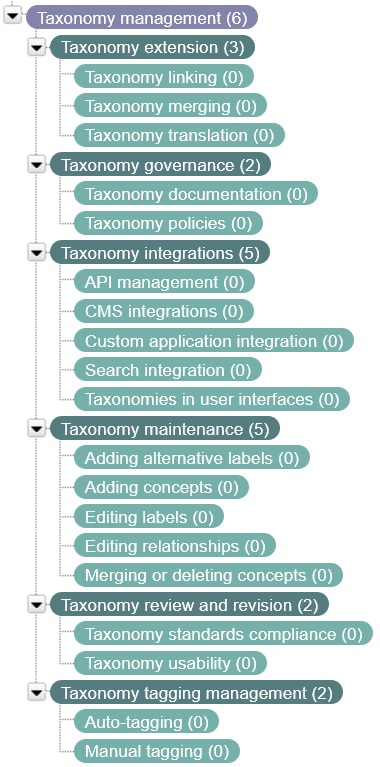As taxonomies become more common for information management and retrieval in all kinds of organizations and in various applications, the task of creating new taxonomies from scratch is less needed than the task of managing existing taxonomies. What is required for taxonomy management, however, might not be completely clear. I’ve written several posts on this blog which I tagged with the topic “Taxonomy maintenance,” but none tagged with “Taxonomy management.” That needs to be corrected. Taxonomy maintenance is part of the larger responsibility of taxonomy management.

Taxonomy management includes the following:
Taxonomy maintenance: adding concepts, merging concepts, editing select labels, adding alternative labels, adding relationships, etc. on an individual concept basis, to keep the taxonomy up to date, as new content and new concepts are introduced and terminology changes. These changes may arise from suggestions from those doing tagging, proactive review of new content and new trends, periodic review of search logs, and periodic text analytics of content. This is an on-going task, that can be done by one ore more taxonomy editors, including those who are subject matter experts. In such cases, the taxonomy-editing work of non-taxonomists should be reviewed by a taxonomist.
Taxonomy governance: developing taxonomy maintenance policies and documentation. This comprises documenting the taxonomy type, features, purpose, ownership, use, etc., and documenting how the taxonomy should be updated to keep its style consistent, including the criteria for adding new concepts to the taxonomy. Taxonomies should be documented when they are created, but sometimes they are not and need to be. Documentation may need to be updated from time to time.
Taxonomy tagging management: developing and updating tagging rules or policies, ensuring tagging quality (comprehensiveness and correctness), and updating or improving the taxonomy if tagging issues indicate it. Tagging can be manual, automated, or automated with human review. Periodic review of the tagging is a necessary task. Even when managing tagging is another individual’s responsibility, managing taxonomies is not completely separate from managing tagging, and this is an ongoing responsibility of the taxonomist who manages the taxonomy.
Taxonomy integration with end-user applications: including websites and web content management systems (CMSs), enterprise content management systems, digital asset management systems, search software, and other custom applications such as recommendation, personalization, and question answering. A taxonomy may be managed within an application, such as a specific CMS or SharePoint, but then it is usable only for that single application. As organizations increase the number of their information management systems, it eventually becomes clear that separate siloed taxonomies are not a good idea, and a single taxonomy should be centrally managed and ported or synced with the taxonomy management components of each tool. Taxonomy application integration involves both technical aspects, such as integrations with APIs, and nontechnical aspects related to user experience, such as considering how the taxonomy displays to the end-users and how they interact with it. Often, an existing taxonomy needs to be adapted to a new application.
Taxonomy review and revision: reviewing a taxonomy for quality standards and against best practices guidelines and checklists, and making general widespread improvements. This includes ensuring that concepts and their labels are clear and unambiguous and that concepts are sufficiently distinct in their meaning, adding alternative sufficient labels (synonyms), ensuring that hierarchical relationships always follow the standards, adding polyhierarchy and associative relationships, changing the capitalization and plural style, ensuring that the hierarchy is not too detailed and deep in some areas. This task is undertaken by a taxonomist or taxonomy consultant only occasionally, especially if the taxonomy will undergo an extension or will be migrated to a new system.
Taxonomy extension: merging redundant taxonomies, integrating complementary taxonomies mapping/linking taxonomies or other vocabularies in the same domain to extend their use, or translating taxonomies to add additional languages. This could include merging or linking a taxonomy and a glossary or terminology or linking the custom taxonomy to an industry standard classification scheme that is familiar to users. Taxonomy extension could also involve adding semantics of an ontology model with custom relationships and attributes. This task is also undertaken by a taxonomist or taxonomy consultant only occasionally.
The inclusion of all of these tasks of taxonomy management requires a dedicated taxonomy/thesaurus management tool, as spreadsheets are insufficient, and the taxonomy editing module of a single application not only tends to lack certain taxonomy management features but will not serve the needs of enterprise-wide taxonomy management. I will discuss this all in more detail in an upcoming PoolParty webinar “Taxonomy Management 101” on August 4. Check back when free registration opens in July.
